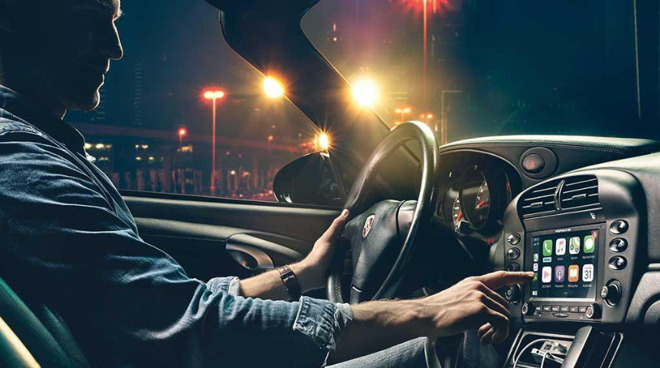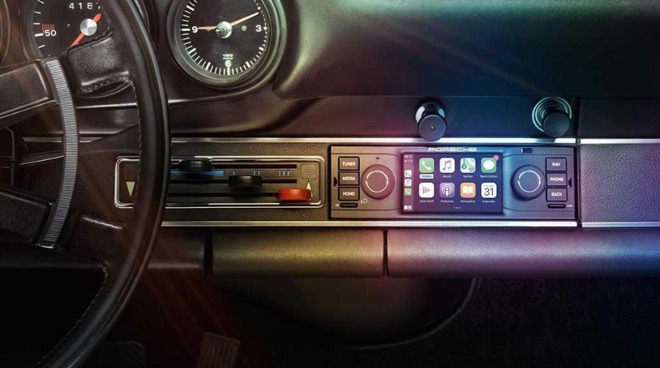Porsche offering stylish CarPlay kits for its vintage automobiles
Owners of vintage Porsche who also love the latest and greatest tech are in for a treat, as the carmaker will now offer official CarPlay kits for their classic vehicles. It's all the functionality you expect from CarPlay, but fits in with the retro dashboard of cars like the famous Porsche 911.

Use CarPlay in your Vintage Porsche
Classic vehicle collectors have always faced a difficult choice between keeping things original or going for third-party solutions when restoring their vehicles, and there is always the question of whether or not to add modern tech. Now Porsche has offered some clarity to those decisions with official CarPlay kits which utilize a new solution called "Porsche Classic Communication Managment" (PCCM).
Rather than dealing with an FM radio or old tape deck that might be more period-accurate but certainly isn't as useful as CarPlay, you now have the option of adding Apple's fully functional infotainment system. It's CarPlay complete with 3.5-inch touchscreen and Siri. Just as you would get with a modern car, Porsche's kit includes support for Bluetooth, USB connections, aux input, and even an SD slot. Fitting it to the car takes advantage of the old single-DIN format, making it simple to do.

The CarPlay kit blends in with Porsche's trim
The PCCM kit comes with knobs and buttons, adding to the vintage feel without interrupting the design of the trim too much. You'll be able to install this on any Porsche from a 1960s Porsche 911 to a 1990s Porsche 993. While Porsche hasn't given details of any other models, it has confirmed compatibility with what it vaguely describes as "earlier front- and mid-engine models."
For vehicles utilizing a double-din system, there is PCCM Plus, which is designed specifically for the Porsche 911 and Porsche 986 Boxster. The double-DIN gives better connection capabilities, so these classic vehicles get a slightly different kit that provides CarPlay on a larger 7-inch screen instead. PCCM Plus also supports Android Auto.
As reported by PistonHeads, the units will cost a pretty penny, not to mention you'll actually need to own one of these classic vehicles first. There are no US prices yet, since they are only for sale in Germany at the moment, but the regular PCCM cost the equivalent of $1,557 US, and the PCCM Plus is $1,738.
If that seems expensive for a car radio, you aren't a classic Porsche owner. To use the PCCM kit, you'll also need, $34,000 for a 1977 Porsche. Or perhaps you'd prefer spending just a little extra and getting a 1963 Porsche 911 for about $250,000. Alternatively, you can get CarPlay in a 2020 Honda Civic that costs around $20,000.

Use CarPlay in your Vintage Porsche
Classic vehicle collectors have always faced a difficult choice between keeping things original or going for third-party solutions when restoring their vehicles, and there is always the question of whether or not to add modern tech. Now Porsche has offered some clarity to those decisions with official CarPlay kits which utilize a new solution called "Porsche Classic Communication Managment" (PCCM).
Rather than dealing with an FM radio or old tape deck that might be more period-accurate but certainly isn't as useful as CarPlay, you now have the option of adding Apple's fully functional infotainment system. It's CarPlay complete with 3.5-inch touchscreen and Siri. Just as you would get with a modern car, Porsche's kit includes support for Bluetooth, USB connections, aux input, and even an SD slot. Fitting it to the car takes advantage of the old single-DIN format, making it simple to do.

The CarPlay kit blends in with Porsche's trim
The PCCM kit comes with knobs and buttons, adding to the vintage feel without interrupting the design of the trim too much. You'll be able to install this on any Porsche from a 1960s Porsche 911 to a 1990s Porsche 993. While Porsche hasn't given details of any other models, it has confirmed compatibility with what it vaguely describes as "earlier front- and mid-engine models."
For vehicles utilizing a double-din system, there is PCCM Plus, which is designed specifically for the Porsche 911 and Porsche 986 Boxster. The double-DIN gives better connection capabilities, so these classic vehicles get a slightly different kit that provides CarPlay on a larger 7-inch screen instead. PCCM Plus also supports Android Auto.
As reported by PistonHeads, the units will cost a pretty penny, not to mention you'll actually need to own one of these classic vehicles first. There are no US prices yet, since they are only for sale in Germany at the moment, but the regular PCCM cost the equivalent of $1,557 US, and the PCCM Plus is $1,738.
If that seems expensive for a car radio, you aren't a classic Porsche owner. To use the PCCM kit, you'll also need, $34,000 for a 1977 Porsche. Or perhaps you'd prefer spending just a little extra and getting a 1963 Porsche 911 for about $250,000. Alternatively, you can get CarPlay in a 2020 Honda Civic that costs around $20,000.

Comments
Think about the common CarPlay taps - tapping at top of screen for a notification, tapping on the left side to switch between maps or music... the smallest I've used it on has been a 6 inch screen.
The nice news about this unit is, there wasn't complex wiring on a 1960s Porsche - Power, GND, switched power, antenna, and 8 audio signals. This radio should work in any single DIN car, if you can imagine paying Porsche prices for it.